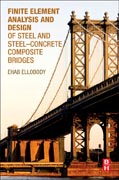
Finite Element Analysis and Design of Steel and Steel-Concrete Composite Bridges
Ellobody, Ehab
In recent years, bridge engineers and researchers are increasingly turning to the finite element method for the design of Steel and Steel-Concrete Composite Bridges. However, the complexity of the method has made the transition slow. Based on twenty years of experience, Finite Element Analysis and Design of Steel and Steel-Concrete Composite Bridges provides structural engineers and researchers with detailed modeling techniques for creating robust design models. The book's seven chapters begin with an overview of the various forms of modern steel and steel-concrete composite bridges as well as current design codes. This is followed by self-contained chapters concerning: nonlinear material behavior of the bridge components, applied loads and stability of steel and steel-concrete composite bridges, and design of steel and steel-concrete composite bridge components. Constitutive models for construction materials including material non-linearity and geometric non-linearity. The mechanical approach including problem setup, strain energy, external energy and potential energy), mathematics behind the method Commonly available finite elements codes for the design of steel bridges. Explains how the design information from Finite Element Analysis is incorporated into Building information models to obtain quantity information, cost analysis, INDICE: 1. Introduction 2. Nonlinear material behavior of the bridge components 3. Applied loads and stability of steel and steel-concrete composite bridges 4. Design of steel and steel-concrete composite bridge components 5. Finite element analysis of steel and steel-concrete composite bridges 6. Examples for finite element models of steel bridges 7. Examples for finite element models of steel-concrete composite bridges
- ISBN: 978-0-12-417247-0
- Editorial: Butterworth-Heinemann
- Encuadernacion: Cartoné
- Páginas: 650
- Fecha Publicación: 12/08/2014
- Nº Volúmenes: 1
- Idioma: Inglés
